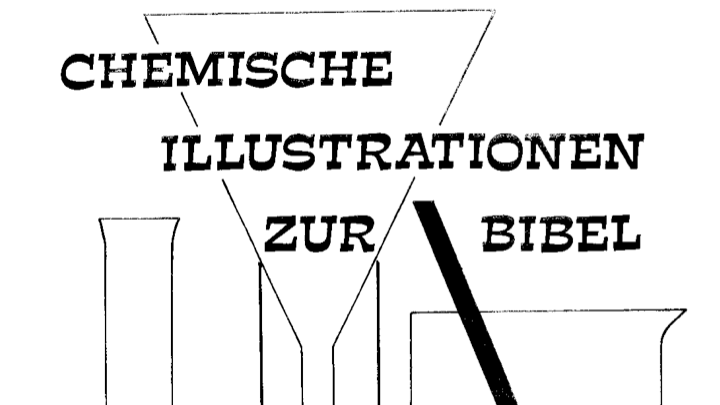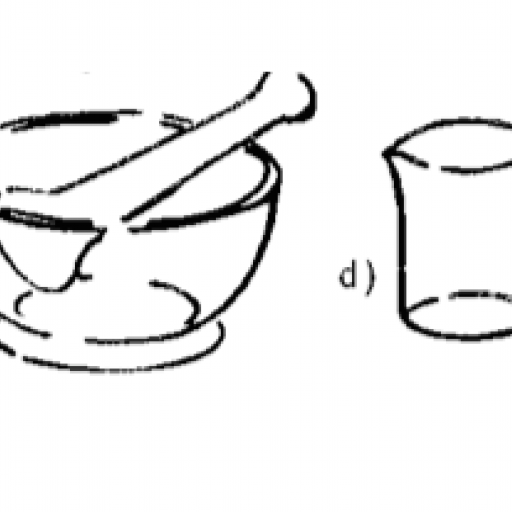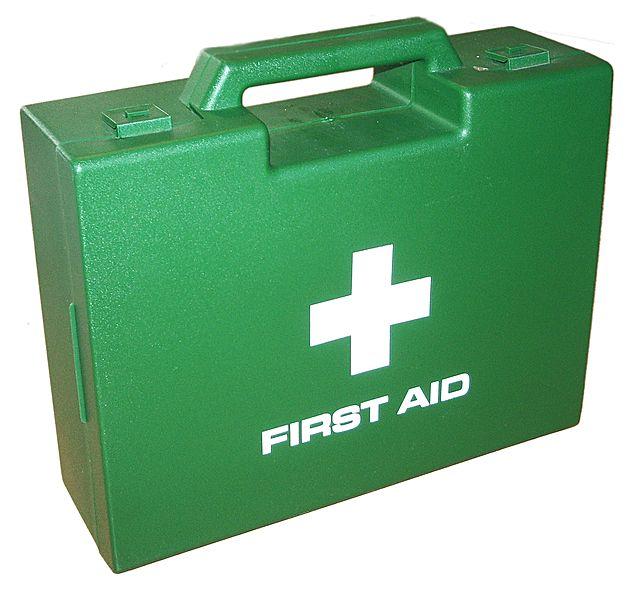This article grew out of a desire to keep finding new ways of proclaiming the Good News.
Caution!
The experiments listed are to be performed only by persons experienced in experimenting with chemical substances, exercising the greatest care, and adhering to all safety regulations.
Table of Contents:
- Chemicals directory (see PDF file)
- Experiments:
- THE FIRE, LUK. 12, 49
- RENOVATION OR RENEWAL, Mt. 9, 14-17
- THE FRUITABLE SOIL OF HEART, Mt. 13, 1-23
- BLOOD FORGIVENESS, Heb. 9:22b
- SELF-RIGHTEOUSNESS, Mt. 7:21-23
- SIN HAS CONSEQUENCES, Mt., 5 14-16
- WASHED IN, 1 John 1:7b
- JESUS LOOKS INTO THE FORGOTTEN, Jn. 4:1-42
- LOUD LIFE OR EMPTY LIFE?, Mt. 16:26
- THE KINGDOM OF HEAVEN, Mt. 13, 31-32
- MIRACLES!, Ps. 86, 10
- THE FEAR OF THE SPIRIT, Gal. 5:22
- THE POISON OF THIS WORLD, 1 John 2:15-17
- LOVE HAS EFFECTS, Mt. 22:37-40
- THE DELIBERATE MESSAGE, Acts 8:26-40
General Information
These "Chemical Illustrations of the Bible" have arisen from the desire to always find new ways in the proclamation of the Good News. In doing so, the writers proceed from the experience that chemical experiments are not only very interesting in and of themselves, but also provide a good simile motivation to lead into a biblical text or fact. If this objective could not be achieved, the proposed experiments would indeed be no more than entertainment; but the leader can escape such one-sidedness by an intensive study of Bible text and experiment. Have fun with it!
For a successful outcome to the chemical experiments, it is of the utmost importance to study carefully the instructions for each experiment, as well as the other rules and directions. Likewise, the provision of materials and substances must be carried out with the utmost care. We recommend that you carry out each experiment yourself beforehand in order to gain the necessary confidence for the demonstration. Here, too, the principle applies: "Practice makes perfect!" Only in this way will you rise above the experiment and find the most unconstrained and thus meaningful transition to the biblical theme to which the chemical experiment relates. Crucial things depend on the confident execution and convincing outcome of the experiment: Not only the ensuing young adult lesson, but perhaps a lifetime...
The "Biblical Application" is deliberately designed to give the leader only information, food for thought, and suggestions for interpretation. It is therefore by no means a completed devotional that could simply be adopted unchanged. Some lines of thought may only become clear once the corresponding chemical experiment has been run through. In addition, it is worthwhile to read the suggested Bible passages in order to be able to read more intensively into the subject. Bible verses that have been written out are always printed in italics. - The transmission suggestions, which have been derived throughout from the chemical experiments, are intended to be as brief as possible, but also as intensive as possible. - It is easily possible to find out here and there other biblical possible applications to the experiments; we can only encourage you to look for other and perhaps better ways.
The instructions for the experiments are divided into the following sections:
Topic:
Short title about the chemical event
Materials:
Statement of substances, apparatus, and other supplies needed
Procedure + Result:
Description of the conduct, procedure and result of the experiment
Caution:
Under this occasional note are special notes regarding toxicity of substances, unexpected reactions, or useful instructions for the success of the experiment.
Thorough preparation also includes heeding the following advice:
1. quantities
The quantities of substances necessary for the experiments are kept so that no unusual measuring vessels need to be purchased. Please keep to the prescribed quantities! Deviations from this are possible (e.g. doubling with correspondingly larger vessels), whereby the quantities given are chosen so that the experiments can be demonstrated conspicuously enough
The knife tip measure refers to the tip of an ordinary table knife rounded at the front. - More precise volume measurements allow for spoonfuls (teaspoon = 5 ml (= cm3), soup spoon = 15 ml) or small tasting cups (with measuring scale).
2. Order
When carrying out the experiments, pay attention to the order given when combining the chemicals, solutions, etc., it is very often crucial.
3. apparatus, vessels
In the choice of apparatus and vessels, special features, i.e., special forms of the chemical laboratory, have been avoided. as a rule, quite ordinary household utensils are sufficient.
a) Pipette (Experiment 6, 7)
b) Erlenmeyer flask (experiments 6, 13)
c) Mortar (grating bowl) with pestle (mortar club) (Experiment 9)
d) Beaker (Experiment 6, 13)
e) Test tubes (Experiment 2, 11)
f) Spray burner (Experiment 11, 13)
g) Filter paper in the form of round filters (experiments 6+13) or filter strips (experiment 8)
4. experimental room
Make sure there is enough free space (table or other demonstration area) for the demonstration of the experiments. This will make the demonstration clearer and more concise: everyone can observe undisturbed without their nose being in front.
Aluminium foil, eternit sheets, newspaper, bricks, etc. are suitable as a protective base. (see notes on the individual experiments!)
5. Safety precautions
Water
Water is used in almost all experiments. Therefore, enough of it (e.g. 10-litre buckets) must be provided in any case.
It is indispensable for carrying out further experiments, for cleaning the table and hands and for extinguishing burning material.
It is advisable to have some old towels, absorbent toilet paper or the like ready for cleaning.
Waste
Where nothing else is mentioned, soluble substances from the experiments should be flushed down the sink with plenty of water.
Poisons
Some of the substances used are toxic. Careful handling is urged. Toxic waste and residues should not be left lying around thoughtlessly, but should be well wrapped or placed in sealed containers (e.g. honey jars) in the waste bin. There is nothing wrong with this procedure, as the quantities of substances used are exceptionally small!
6. place of reference
All substances listed in the following list can be obtained from specialist shops (drugstores, pharmacies). For the purchase of substances of poison classes 2 and 3, poison certificates (for class 2 from the political municipality, for class 3 from the specialist shop), as well as possibly an identity card (adult proof) are necessary
It is essential to handle the substances responsibly! They must be kept in closed containers in an inaccessible place. You yourself bear the responsibility! Poison residues that are no longer usable are to be returned to the specialist shop after use.
7. List of chemicals
(see attached PDF file)
TEMPT 1: THE FIRE
I HAVE COME TO BURN FIRE ON THE EARTH, AND HOW WOULD I LIKE IT TO HAVE BEEN BURNED OUT ALREADY! (Luk, 12, 49)
1st try
subject
Red bengal light
Material
- Strontium nitrate
- Sulfur powder
- Potassium nitrate
- Wood charcoal (very finely pulverized; possibly use activated charcoal)
- 1 teaspoon
- 1 knife
- 1 base (brick or iron sheet with wooden base)
- 1 yogurt pot
- Matches
- Linsoft (paper handkerchiefs)
The darker the room available, the greater the effect of the experiment!
Procedure
In succession, the following amounts of the reactants are sprinkled into the yogurt cup:
- one heaping teaspoon of strontium nitrate
- One level teaspoon of sulfur powder
- Four pinches of potassium nitrate
Now mix the whole thoroughly with a spoon, so as to obtain an evenly coloured mixture.
First now the 4th substance, half a teaspoonful of charcoal, is to be added.After another mixing procedure, the mixture is to be piled steeply on the brick and ignited with two parallelized matches (see sketch under Experiment 10). At the same time the light is extinguished.
Result
The substance mixture burns bright red.
Caution
The resulting vapours can cause coughing irritation in individual young sharers, but this is completely harmless and temporary. It is therefore recommended to ventilate briefly.
If the substances are measured with the same spoon, this should be cleaned well with Linsoft in between to prevent uninvited reactions in the substance vessels.
The two salts strontium and potassium nitrate are slightly toxic!
Biblical Application
A spark is all it takes ...
...to ignite a mighty fire! Jesus Christ did not just light a spark, but a mighty fire right away. This fire is what the passage in Luke 12:49 is talking about, which means this:
- The fire of the Holy Spirit, which Jesus Christ kindled on Pentecost, was already foretold by John the Baptist (Luk 3:16). Jesus himself points the disciples several times to the coming of the Holy Spirit, who is not only to work with them, but even in them (Joh. 14, 16-18 + 26 / Joh. 16, 7-14).
- The fire of love: Jesus Christ proclaimed a new commandment, the commandment of love (Joh. 13, 34). Probably no "method" has ever warmed people to Jesus more than genuine love, a fire that, combined with prayer and work, is capable of accomplishing great things.
- The Fire of the Word of God: When the Word of God is compared to a fire in Jeremiah 23:29, this verse is indeed in the Old Testament, but mission history in the New Testament and beyond shows us how the Word of God was proclaimed and set whole groups of people on fire by its great power. Precisely because the Holy Spirit works on and in people since Pentecost, the Word of God again and again plays the role of an igniting fire (Rom. 10, 17)
If the fire burns ...
... in your life? This question decides everything! If we do not let the fire of Jesus set us on fire, the hellish fire will seize us all the more surely (Rev. 20:15). This is by no means a matter of scaremongering; and yet the fact of divine judgment must also be mentioned. Jesus Christ desires nothing more than that His fire may be kindled in individuals, in our young people. He wants to kindle this fire of the Holy Spirit and love especially in the young people (Eccl. 12, 1 / Mt. 18, 12-14) and nourish them with the Word of God. If he wants to be kindled by the fire of Jesus Christ?
Every fire leaves traces!
When the fire of Jesus Christ burns in our lives and gains space, it burns up everything base, the fruits of the flesh (Rev. 3, 18 / Gal. 5, 19-21). A well fertilized soil (of the heart) where fruits of the spirit (Gal. 5, 22) can grow, remains. Only when the old burns away, something new and permanent can grow!
Trials 2 - 15 are similarly designed
For details see PDF file
Source reference:
Content and pictures:
copyright: Bund Evangelikaler Schweizer Jungscharen (Jungschar-Sekretariat, Ufenaustr. 11, 8807 Freienbach)
Authors: Dr. E. Grieshaber, H. Steiner
Content may be automatically translated. Help improve the quality of the translation with your editing!



